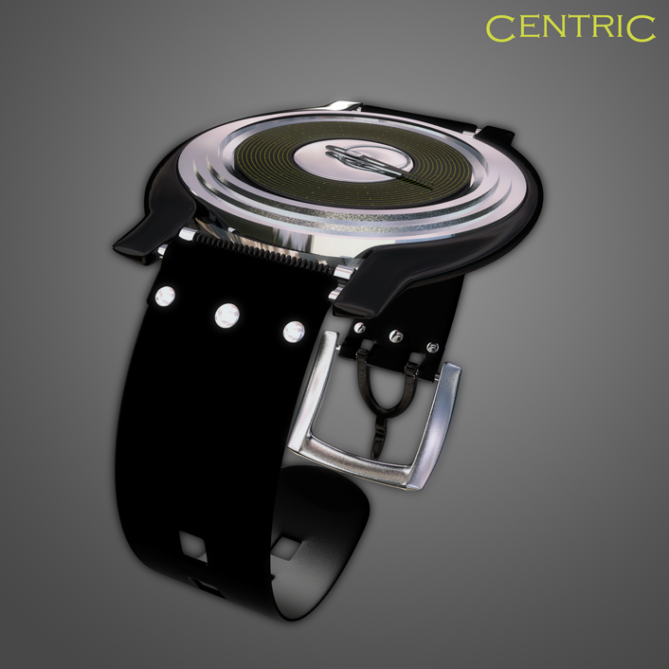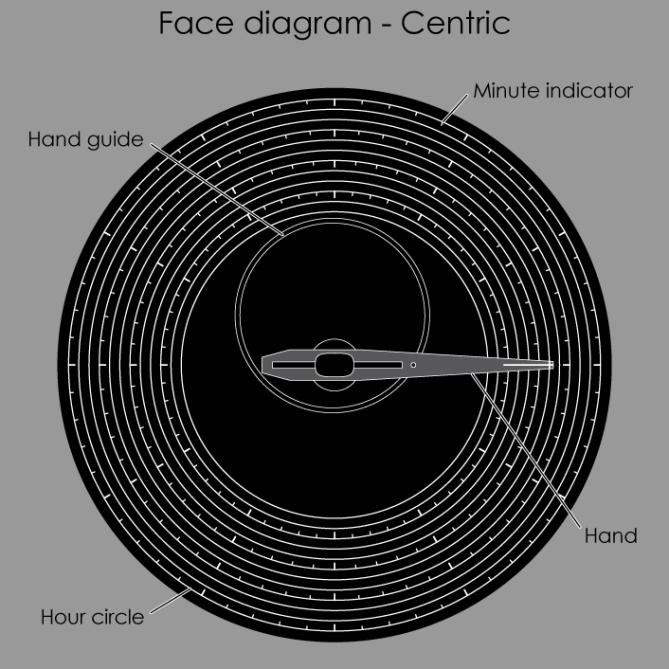Design submitted by Anders from Sweden.
Anders says: This is Centric, an attempt at a one-hand watch concept. I’ve been wrestling with the idea for a while, trying to get it to work, and this is the result. I’ve tried to keep the styling subtle to correspond to the mechanical simplicity of the design.
Time is told by a single hand that rotates like a standard watch to indicate the minutes, and slides radially to indicate the hour; inward 00:00-12:00, outward 12:00-00:00. A tritium cross on the hand matches the tritium dial and aids readability, both during the day and at night.

Centric should appeal to fans of unusual takes on classic design cues. The tritium dial and steel body gives it an almost military feel, while the single hand lends a minimalistic touch. It is clearly a man’s watch, but slightly different styling should be able to make it suitable for women as well.
The main selling point of this concept is the deceptively simple time telling, which gives it a unique flavour and a very clean look. The simplicity and the solid materials should also make it quite durable, like a militaresque design should be.





I would so wear this…
LikeLike
Thanks Eric, I hope you’ll get the opportunity! =)
LikeLike
Holy cow! If only there was a company out there that exclusively designed your watches, Anders! This is so my taste – 5* and an emphatic YES!
Cheers,
DZ
LikeLike
Whoa, high praise there! *bows*
Thanks a lot for the vote!
LikeLike
Very simple but very clever idea, looks great too! The only thing that needs tweaking for me would bigger gaps between the hour rings for extra clarity, but that’s a minor detail. Congrats sir. 5/Y best of luck! 😀
LikeLike
Thanks for the vote and support Pete!=)
Yeah, I see what you mean about the clarity… The problem with the design (as it looks now) is that the size of the guide groove for the hand dictates the size and width of the face. I suppose you might be able to layer them; put the guide groove underneath the face, but then you wouldn’t see the mechanics of it (and I do love my mechanics…=)
Hm, just had the idea of putting the groove on the underside of the glass…? =)
Although, the simplest solution might be to reduce the number of hour rings to 6, and making the hand travel in and out twice in 24 hours… But then you’d need some indication of which direction it’s moving… Gaah, there’s never a single correct answer, is there? =)
LikeLike
Maybe if the odd or even rings were a different width or colour/shade this would help with the reading without spoiling the look. Would be a shame to compromise the aesthetic cos it looks great! 😀
LikeLike
Yep, there are many ways to skin a cat, my friend…=)
As you can see above every third ring has minute markers. If you put them on every other ring it’d be more difficult to tell them apart, and I suspect making every other ring thicker/thinner would just make it more confusing… An interesting problem, no doubt… Which is of course code for ‘bugger me if I know what to do about it’…=)
LikeLike
Thanks TF for posting!
LikeLike
Very nice design. The idea isn’t 100% original because a model similar is posted in Watch Museum page 3… http://www.tokyoflash.com/en/watch_museum/eleeno/one_hand/
Your design is looking better. Keep up the good work.
LikeLike
In my experience, few ideas are even 50% original…=) Thanks for the link, I hadn’t seen that one!
And thanks for the support!
LikeLike
5/5 – absolutely smashing! I have one comment, an observation, two questions, and two suggestions.
Comment:
> Ander, what you’ve designed is 100% original as far as I’m aware. I’m not an expert, but I spend a lot of my leisure time learning about watches. I’ve seen single hand watches and I’ve seen watches that have extending and receding hands. I’ve never seen a single hand watch that used a minute hand rather than an hour hand. I think that that’s unique. I’ve never seen a watch that uses the extending of a hand as part of the display. The watches with extending hands I’ve seen have that feature because the watch face has an irreguglar shape.
Questions:
>How do I know if it’s 11:04pm instead of 1:04am? I understand that outward and inward motion of the hand indicate am & pm, but I can’t see the hand moving at any particular moment.
>I have one concern about the sliding hand. Have you thought about friction? If it were a mechanical watch rather than quartz, then this would be a much more serious concern, but I think it still it’s worth considering. I don’t know how much resistance a battery operated watch can tolerate, but it stands to reason that there’s some upper limit which would stress it enough to cause damage. After all, they’re designed to use as little energy as possible and usually the hands are swinging free. I know that if you’re building a clock with heavy arms (either because they’re very long or very ornate) it’s best to get a high torque movement to deal with the added weight. It would seem that having the arm dragged by the guide might raise the same sort of issues.
Observation:
>You won’t be able to use a standard movement. You’ll need a specialized one designed for 24 hour analog dials with a 24:1 reduction gear train to turn the disk with the guide on it rather than a standard 12:1.
Suggestions:
>You could add a day/night indicator to distinguish between the outward and inward (am & pm) hours.
>Surely you’ve noticed how much your design is reminiscent of an old fashioned record player (phonograph). I’m not old enough to have ever bought records, but my parents used to play records when I was growing up. The black minute indicator with all of the concentric hour circles looks like an LP. The hand looks like a tone arm, and tone arms had to move inward as the needle went from the outside toward the center of the record. Your hand is being dragged inward (and outward) by a “needle in a groove” too. Why not call your design the Needle&Groove watch?
LikeLike
Thanks for the vote and the substantial comment! =)
I had the idea of making a Salvador Dali-inspired design with an irregular shape when I was working on this one, but I didn’t have the energy…=)
The in- or outward motion of the hand could be read from the guide groove. If the wearer knows in what direction it rotates, it’s very easy to tell. The groove might also have tritium markings, to make it as readable as the rest.
Friction might conceivably be an issue, yes. However, the hand would be very light and wouldn’t be able to cause enormous amounts of it. It’d need solid engineering to avoid making it too power-hungry. though… Judging by what they’ve managed in the past, I’m sure the TF boffins would be able to sort it very nicely.=)
you might use a piezo-electric motor, come to think of it. That should sort any friction trouble…
If my mental arithmetic is what it should be, then you wouldn’t need a terribly custom movement. The minutes work as on any other watch, and the guide groove needs to be geared to rotate one revolution more than the minutes per 24 hour period.
Actually, I didn’t think about the record player connection before you mentioned it…=)
I think someone submitted one like that some time ago… Can’t remember who it was, unfortunately…
If I were to do something like that I’d probably like to put the arm outside of the ‘record’, to really go with the analogy…
LikeLike
The concept of showing the time with one hand is not new but the method of doing so is the interesting detail here 😉
LikeLike
Dan, I disagree about Ander’s originality.
It’s worth looking back at how watches evolved. One handed watches are actually the oldest kind that there are. When watches were first being made, adding a minute hand required an extra level of complexity to the movement which was difficult given that making very small precise gears was the cutting edge of technology. Also, bear in mind that these early watches were not wristwatches, but much larger pocket watches since they couldn’t make works to fit into cases any smaller. Every added ‘complication’ made a watch (or a clock for that matter) harder to build, so the two hand watch is newer and the second hand newer still. Later we got calendar, moon phase, chronograph, and a whole lot of other fancy additions which watchmakers added to show their technical proficiency. Moreover when you go that far back in history, most people didn’t really need a minute hand. If you were a navigator, or later on a train conductor, it would matter, but most people did fine with knowing it was nearly a quarter past five rather than 5:13 or 5:14.
So, you’re right that a single hand isn’t new. It’s as old as watched themselves, but single handed watches have always had the *hour* hand as the single hand. Ander has a single minute hand. That’s new as far as I know.
LikeLike
Here’s a link to a pic of the earliest known watch- notice that it has only an hour hand and no minute hand.
From Wikipedia, “1500–1600 Clock-watches: The first timepieces to be worn, made in the 16th century in the German cities of Nuremberg and Augsburg, were transitional in size between clocks and watches. These ‘clock-watches’ were fastened to clothing or worn on a chain around the neck. They were heavy drum shaped cylindrical brass boxes several inches in diameter, engraved and ornamented. They had only an hour hand.”
Clocks began to have minute hands in the late 1400’s, but it was much later when they were added to watches
LikeLike
Analouge isnt my first choice in a watch but I’d happily buy this because it looks good, great work 🙂 5/Y
LikeLike
Thanks for the vote! =)
LikeLike
I have some ideas about how this design might be modified so that it would be easier to tell the time – ie, the problem of out vs in movement differentiation and how close together the hour rings are. If you’d be interested, let me know.
LikeLike
Yeah, it’s always interesting to know what other people’d do differently.
LikeLike
This looks good. I’m wondering if you would consider making this time-telling method into a business-style watch. I want to funnel my watch budget into TokyoFlash, but I need something professional-looking! This seems like it could be the style to hit that niche.
LikeLike
Glad to hear you like it (at least for its potential), and I’m intrigued to know exactly what you mean by ‘business-style’. How’d you like it to look? What whould you change? Detailed feedback is always welcome! =)
LikeLike
I like the overall look. The white part could be thiner ( at the exterior ) and the dial wider. I have a minor concern with the way to tell the hour : how do you know if it’s going inward or outward ? Also : is the “hand guide” used for something ?
LikeLike
Thanks for the comment! The hand guide is the groove which rotates to slide the hand in and out. Provided the wearer knows what direction it rotates, it’s easy to tell if the hand’s travelling in or out.
LikeLike
ty for the explanation.
LikeLike